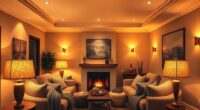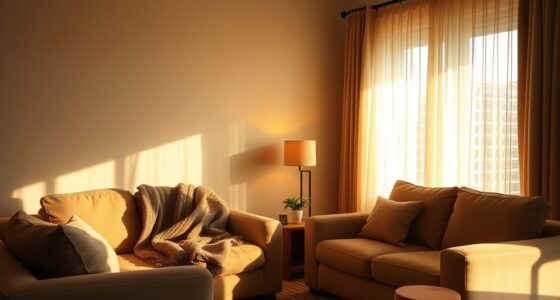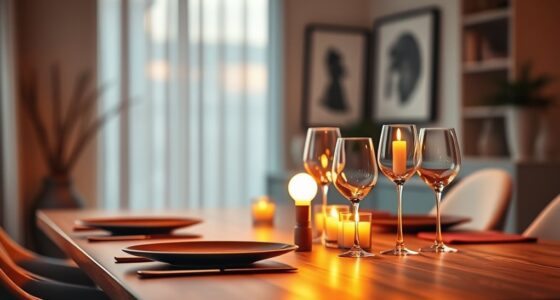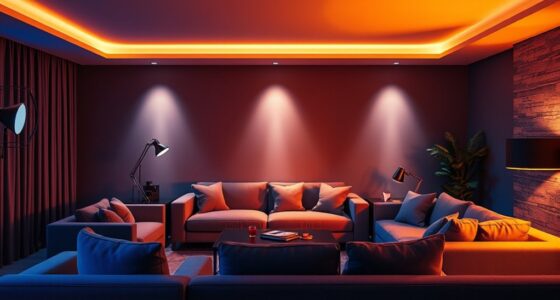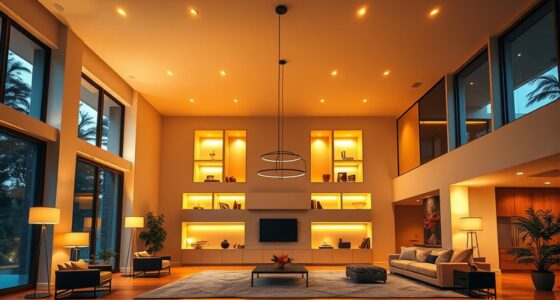Candlelight creates a warm, flickering glow that promotes relaxation, intimacy, and a cozy atmosphere, while LED lighting offers bright, steady illumination ideal for clarity and focus. Candles support better sleep by mimicking natural light, but they can pose fire and health risks. LEDs are energy-efficient and safer but may disrupt circadian rhythms if used excessively at night. Want to discover how to choose the perfect mood lighting? Keep exploring the truth behind candlelight versus LEDs.
Key Takeaways
- Candlelight creates a warm, flickering ambiance that fosters intimacy and relaxation, unlike the steady, bright illumination of LEDs.
- Candles support natural sleep cycles and circadian rhythms with their dim, warm glow, while LEDs’ blue light disrupts sleep.
- While candles are eco-friendly if sustainably sourced, they pose fire hazards and indoor air quality concerns; LEDs are safer but have environmental disposal impacts.
- Candles evoke cozy, romantic atmospheres ideal for relaxation; LEDs offer adjustable brightness and color for versatile mood setting.
- Long-term, LEDs are more energy-efficient and cost-effective, but candles enhance emotional comfort and ambiance with their natural, warm light.
The Psychological Impact of Candlelight and LED Illumination
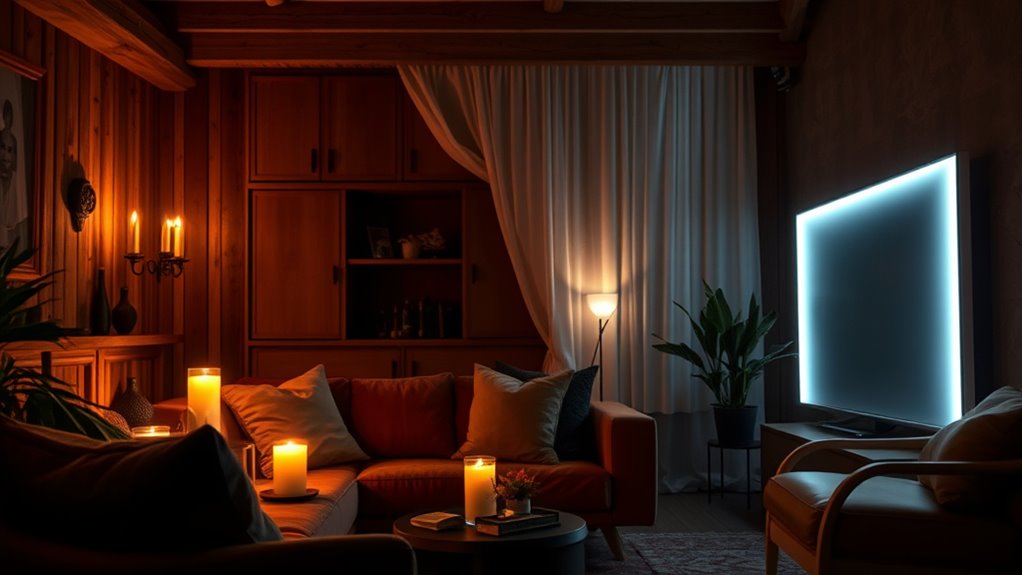
While both candlelight and LED illumination can influence your mood, they do so in markedly different ways. Candlelight creates a warm, flickering glow that fosters emotional comfort, making you feel relaxed and at ease. Its soft, uneven light enhances your visual perception by adding depth and intimacy to a space, encouraging calmness and connection. In contrast, LED lighting provides bright, steady illumination that can feel clinical or harsh, sometimes reducing emotional comfort. Its consistent light can make environments seem more functional but less inviting. You notice how candlelight’s gentle glow encourages reflection and comfort, while LED’s clarity promotes alertness. Understanding these psychological impacts helps you choose lighting that aligns with your desired emotional atmosphere. Additionally, the lighting quality can influence your overall sense of well-being and mood.
How Lighting Affects Our Circadian Rhythms and Sleep Patterns

Lighting plays a significant role in regulating your body’s internal clock, known as the circadian rhythm. When exposed to bright or blue light at night, your circadian disruption increases, making it harder to fall asleep and reducing sleep quality. Conversely, dim, warm lighting like candles can support your natural rhythm, promoting better rest. The type of light you choose influences hormone production, especially melatonin, which signals your body to sleep. To visualize this, consider the table below:
| Light Type | Effect on Circadian Rhythm | Impact on Sleep Quality |
|---|---|---|
| Candlelight | Supports natural cycle | Enhances sleep |
| LED (daylight) | Disrupts circadian rhythm | Reduces sleep quality |
| Blue light | Causes circadian disruption | Impairs sleep |
Additionally, understanding the effects of different light sources can help you make informed choices for better sleep health.
Environmental Footprint: Comparing the Sustainability of Candles and LEDs
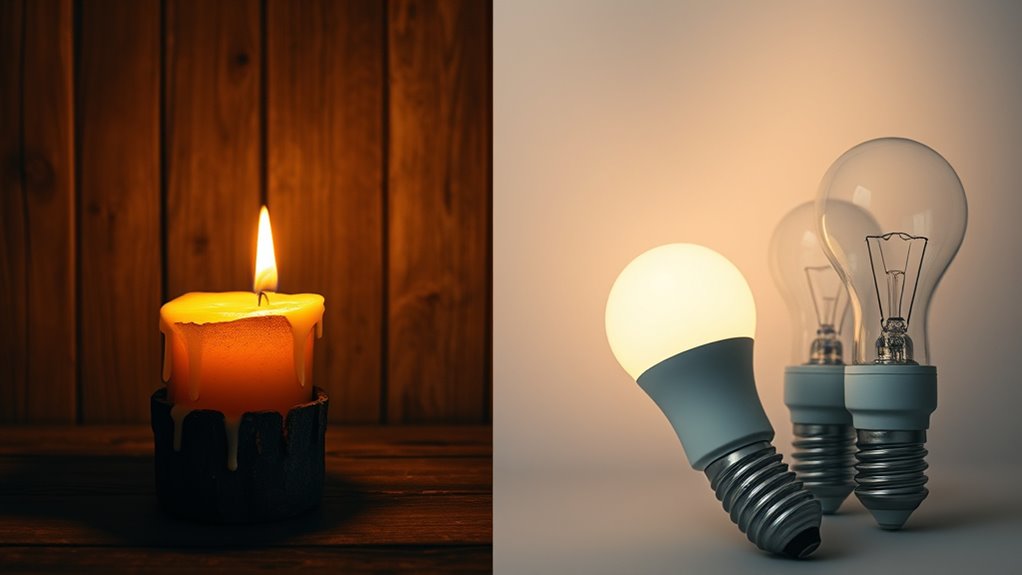
When evaluating the environmental impact of candles versus LEDs, it’s important to contemplate their resource consumption and waste. Candles typically use renewable resources like beeswax or soy, which can be more sustainable if sourced responsibly. However, they produce waste such as used wicks and packaging. LEDs, on the other hand, rely on electronic components and rare metals, which involve significant ecological impact during mining and manufacturing. While LEDs consume less energy over time, their production and disposal pose environmental challenges. Your choice affects sustainability: candles can have a lower ecological footprint if made from eco-friendly materials, but LEDs offer energy efficiency benefits. Additionally, the lifecycle of each lighting option influences their overall environmental impact. Ultimately, understanding their resource use and waste helps you make a more sustainable decision aligned with environmental preservation.
Health Considerations: Are Candles Safer Than LEDs?
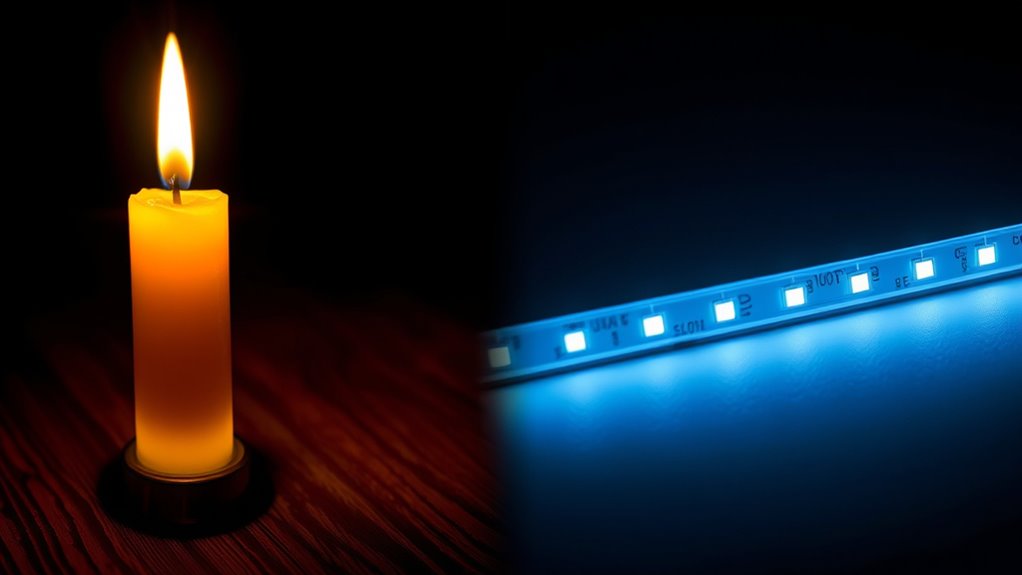
Candles can pose health risks due to the release of indoor pollutants, especially if burned improperly or if they contain synthetic fragrances and dyes. These emissions can negatively impact air quality and increase allergen exposure, potentially triggering respiratory issues or allergies. You might not realize that burning candles can produce soot and volatile organic compounds (VOCs), which linger in the air. Additionally, practicing mindful creative practice when selecting candle types can help reduce exposure to harmful substances. Consider these points:
- Candles with synthetic fragrances release harmful chemicals into your environment.
- Soot from candles can settle on surfaces, affecting indoor air quality.
- Allergens from certain dyes or scented candles may worsen allergy symptoms.
While LEDs emit no pollutants, candles require careful use to minimize health risks. Always ensure proper ventilation and choose natural options when possible.
Cost Analysis: Which Lighting Option Is More Economical in the Long Run?
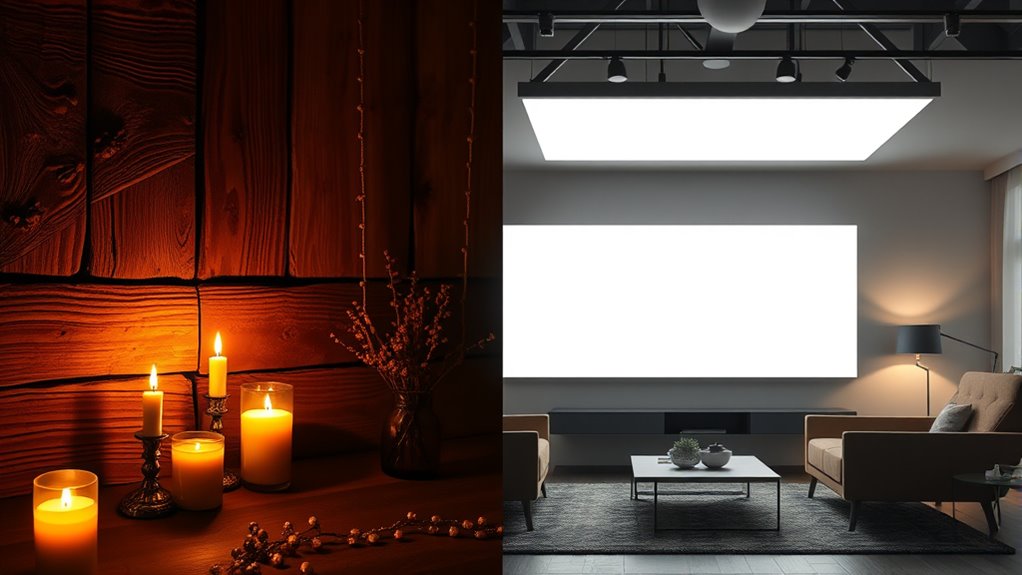
While candles may create a cozy atmosphere, they often cost more over time due to frequent replacements and higher energy consumption if used with decorative lighting. When doing a cost comparison, LEDs clearly come out ahead, as they use considerably less electricity and last much longer. Maintenance costs for LEDs are minimal—just occasional bulb replacements—whereas candles require regular purchasing and careful handling to prevent accidents. Over the long run, LEDs tend to be more economical because they save you money on energy bills and replacement costs. Additionally, the energy efficiency of LED lighting makes it a more sustainable choice for both your wallet and the environment. Although initial investment in LED bulbs can be higher, the durability and efficiency make them a smarter financial choice. If you’re looking to cut costs without sacrificing mood lighting, LED options are definitely the better deal.
The Aesthetic and Ambiance Differences That Influence Mood
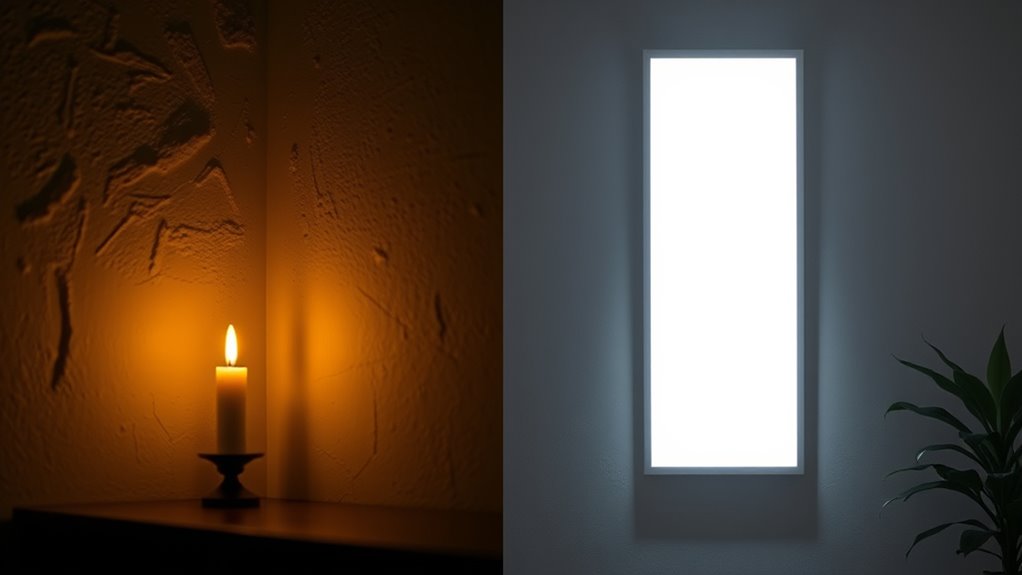
You notice how candlelight’s warm glow creates a cozy, intimate atmosphere, while LEDs often emit a cooler, steadier light. The flickering of candles adds a dynamic, lively feel that can lift your mood, unlike the constant brightness of LEDs. Color and intensity also play a role, shaping how relaxed or energized you feel in a space. Additionally, the beneficial ingredients in eye patches can enhance the overall appearance of the eye area, contributing to a more refreshed look.
Warmth and Glow
The warmth and glow of lighting can dramatically shape the atmosphere in any space, influencing how you feel and relax. Candlelight offers a soft, flickering glow that creates a cozy, inviting environment, enhancing heat comfort and aesthetic appeal. LED lights, on the other hand, provide a steady, bright illumination that can feel less intimate but more functional. Consider these points: – Candlelight’s flickering glow fosters intimacy and relaxation. – LED’s consistent brightness increases clarity and visibility. – The warm hue of candles adds to heat comfort and aesthetic charm. Your choice affects not just the mood but the overall vibe, making your space feel either more soothing or more energizing. Both options influence the ambiance, but in uniquely different ways. Lighting types play a significant role in shaping the overall atmosphere and mood of your space.
Flicker vs. Steady
The flickering action of candlelight creates a dynamic, animated atmosphere that feels warm and inviting, while steady LED lighting establishes a calm, orderly environment. The flickering ambiance of candles adds a sense of movement and life, making your space feel more intimate and cozy. It draws your attention and encourages relaxation through its unpredictable, natural glow. In contrast, steady illumination from LEDs provides consistent, uniform light that fosters focus and clarity. This steady lighting reduces visual distractions, helping you concentrate or unwind without interruption. Your mood shifts depending on the lighting style you choose; flickering creates an energetic, nostalgic vibe, while steady light promotes tranquility and stability. Both styles influence your atmosphere, but their core aesthetic and emotional effects are distinctly different. Additionally, lighting effects play a significant role in shaping the overall ambiance and emotional response in any space.
Color and Intensity
Color and intensity play crucial roles in shaping the mood created by candlelight and LED lighting. Your perception of space and emotion depends heavily on how these elements interact. Candlelight often produces warm, soft hues that invoke calmness through color psychology, encouraging relaxation and intimacy. LED lighting offers a broader range of brightness and color options, allowing you to adjust light intensity to match your desired atmosphere. Additionally, ambient lighting conditions significantly influence how these light sources affect our mood and environment.
Safety Aspects and Potential Risks of Candle and LED Use
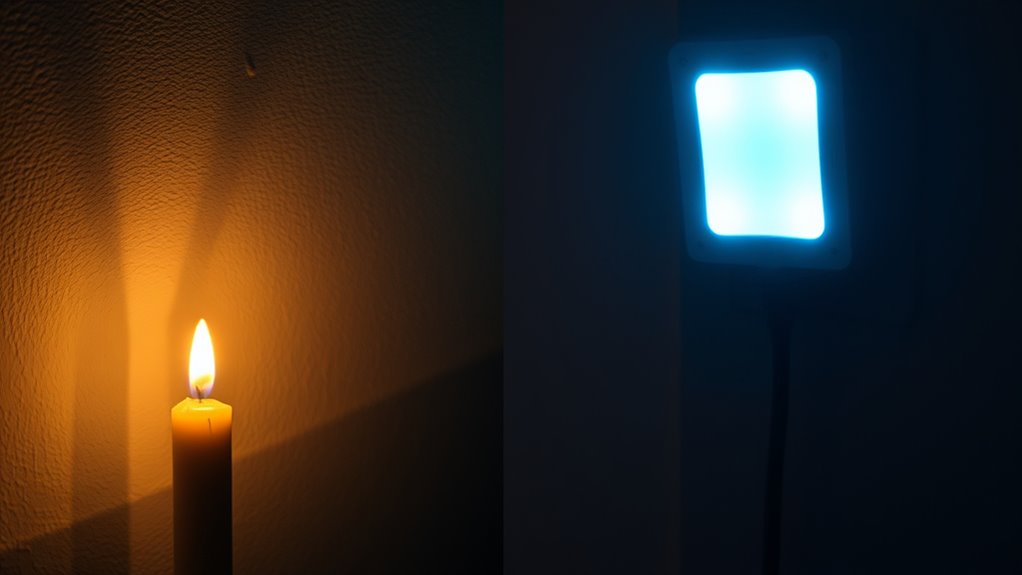
Both candles and LEDs come with safety concerns you should consider. Candles pose a fire hazard if left unattended, while LEDs are generally safer but can still cause eye strain or skin irritation if mishandled. Understanding these risks helps you use each lighting option more responsibly. Additionally, ensuring proper lighting safety practices can further minimize potential hazards associated with either choice.
Fire Hazard Risks
While candles create a warm and cozy ambiance, they also pose notable fire hazards if not used carefully. To guarantee fire safety and hazard prevention, you need to stay vigilant. Unattended candles can easily ignite nearby objects or fall over. Always place candles on stable, heat-resistant surfaces and keep them away from curtains, paper, or flammable decorations. Never leave a lit candle unattended, especially around children or pets. Be cautious when handling candles to avoid accidental spills or drops. For LED lighting, the fire risk is minimal, but overheating or electrical faults can cause fires if devices are damaged or improperly installed. Remember, practicing proper safety measures can considerably reduce the risks associated with candle use and help prevent dangerous fires.
Eye and Skin Safety
When using candles and LEDs, safety isn’t just about fire prevention—it also involves protecting your eyes and skin from potential hazards. Candles emit UV radiation, which can cause skin aging and eye strain if you’re exposed for extended periods. Additionally, chemical emissions from burning candles, such as soot and fragrances, may irritate your skin or trigger allergies. LEDs, on the other hand, generally produce minimal UV radiation but can emit blue light that strains your eyes over time. Some LEDs also contain phosphor coatings or other chemicals that, in rare cases, could pose skin contact risks if damaged. To stay safe, avoid prolonged exposure to direct candlelight, and choose LED options with low blue light emissions. Proper ventilation helps reduce chemical buildup regardless of your choice.
The Role of Lighting in Enhancing Romantic and Relaxing Environments

Lighting plays an essential role in setting the mood for romantic and relaxing environments, shaping how you feel in a space. Soft, warm lighting creates a cozy atmosphere that encourages intimacy and tranquility. Using decorative accents like string lights or candles adds visual interest and enhances the ambiance. LED options offer energy efficiency, allowing you to enjoy the desired mood without high electricity costs. Consider how different light sources influence the overall vibe:
- Warm-colored lights for intimacy and comfort
- Dimmer switches to control brightness easily
- Decorative fixtures that complement your style
Innovations and Future Trends in Mood Lighting Technology
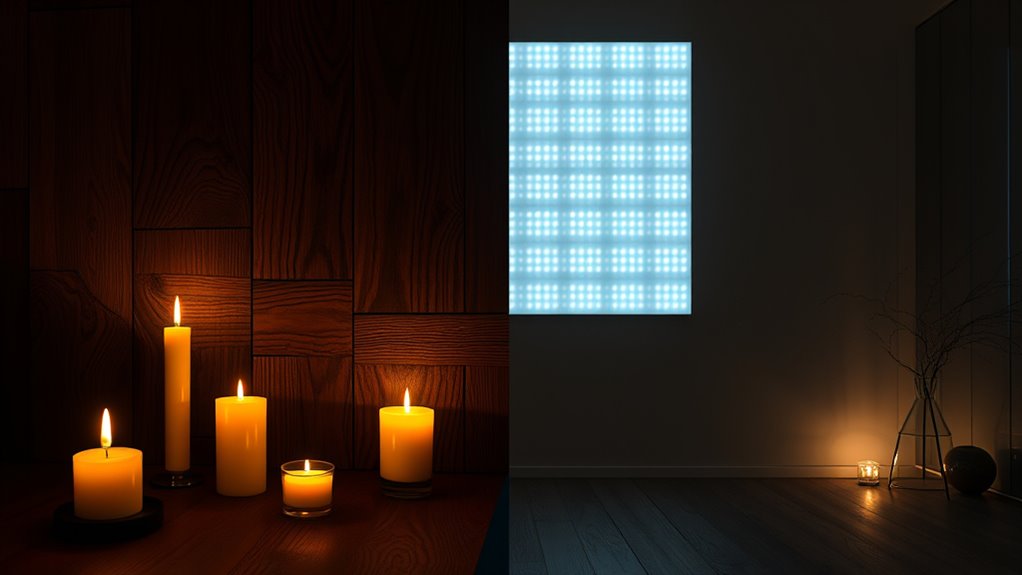
Today’s mood lighting tech is moving toward smarter, more integrated systems that adapt to your preferences seamlessly. You’ll see advancements in color-changing technologies that respond to your mood or environment in real time. These innovations promise a more personalized and dynamic lighting experience for any space.
Smart Lighting Integration
As smart lighting technology continues to evolve, integrated systems are transforming how you create mood and ambiance in your spaces. With smart customization and app control, you can tailor your lighting to match your mood instantly. Imagine adjusting brightness, color, and even schedules right from your smartphone, seamlessly syncing your lights with your daily routine. These innovations enable you to:
- Easily set the perfect atmosphere with a few taps
- Automate lighting to respond to time or activity
- Personalize settings for different rooms and occasions
Smart integration makes mood lighting more intuitive and flexible, giving you complete control over your environment. As these systems advance, you’ll enjoy a more immersive, personalized experience that adapts effortlessly to your preferences.
Adaptive Color Technologies
Innovations in adaptive color technology are pushing mood lighting beyond simple control, allowing for dynamic and personalized experiences. With advanced color adaptation, lighting systems can now respond to your mood, time of day, or activity, creating the perfect atmosphere effortlessly. These technologies enable seamless dynamic lighting, shifting colors smoothly to match your desired ambiance. Future trends focus on intelligent algorithms that learn your preferences, adjusting automatically to enhance relaxation, focus, or energy. You’ll find that adaptive color systems can sync with your routines, providing a more immersive environment. As these innovations evolve, mood lighting becomes more intuitive and customizable, transforming your space into a truly responsive setting that adapts to your mood and needs in real-time.
Practical Tips for Choosing the Right Lighting for Your Space

Choosing the right lighting for your space involves considering both function and atmosphere. To create the perfect environment, focus on selecting fixtures that complement your decor and meet your needs. Look for decorative fixtures that add style and personality, enhancing your space’s overall look. Prioritize energy efficiency by choosing LED bulbs or fixtures that save power and last longer, reducing long-term costs.
Here are some practical tips:
- Match lighting styles with your room’s decor to enhance aesthetic appeal.
- Opt for dimmable fixtures to easily adjust brightness and mood.
- Consider energy-efficient options to cut down on electricity bills and environmental impact.
Frequently Asked Questions
Can Candlelight Improve Mental Health Better Than LEDS?
You might wonder if candlelight can boost mental health more than LEDs. Candlelight’s psychological effects include promoting relaxation benefits, helping reduce stress and anxiety. Its warm, flickering glow creates a calming atmosphere, making it easier to unwind. While LEDs provide bright, efficient lighting, they lack the soothing ambiance of candles. For mental well-being, choosing candlelight could enhance your relaxation and positively influence your mood.
Do LEDS Emit Harmful Blue Light That Affects Eye Health?
You might notice your eyes feeling strained after long screen time, especially with LEDs emitting blue light. This blue light can lead to retinal damage over time and disrupt your sleep. While LEDs are energy-efficient, their blue light exposure poses potential risks. To protect your eye health, consider reducing screen time, using blue light filters, or opting for warmer lighting options to minimize blue light exposure.
How Does Candle Scent Influence Mood Compared to LED Lighting?
You might notice that candle scents considerably influence your mood more than LED lighting. Aromatherapy and scent psychology show that pleasant aromas can reduce stress, boost relaxation, and lift your spirits. When you burn candles, the warm glow combined with soothing fragrances creates a calming atmosphere, unlike the often neutral or harsh LED light. So, choosing scented candles can enhance your emotional well-being and create a cozy, inviting environment.
Are There Eco-Friendly LED Options Available?
You’re wondering if eco-friendly LED options exist. Yes, many sustainable lighting choices are available that are both energy-efficient and environmentally friendly. Look for LEDs made with recycled materials or those certified by eco-labels, ensuring minimal environmental impact. These energy-efficient options reduce electricity use and carbon footprint, helping you create a greener home. Switching to sustainable lighting makes a positive difference for the planet while providing the lighting you need.
Which Lighting Type Is Better for Indoor Air Quality?
You should consider indoor air quality impact when choosing lighting. LEDs generally emit fewer pollutant emissions and don’t produce smoke or soot like candles, which can release particulate matter and other pollutants into the air. This means LEDs are better for maintaining healthier air quality indoors. If you want to reduce airborne pollutants and improve your living environment, opting for eco-friendly LED options is a smart and safer choice.
Conclusion
Choosing between candlelight and LEDs isn’t just about brightness—it’s about transforming your space and mood. Whether you crave the warm glow of candles or the sleek efficiency of LEDs, your lighting choices shape your well-being and environment more than you realize. So, pick wisely, because the right lighting has the power to turn your home into a sanctuary of serenity or a hub of electric energy. Your mood depends on it—don’t let dull lighting steal your glow!

